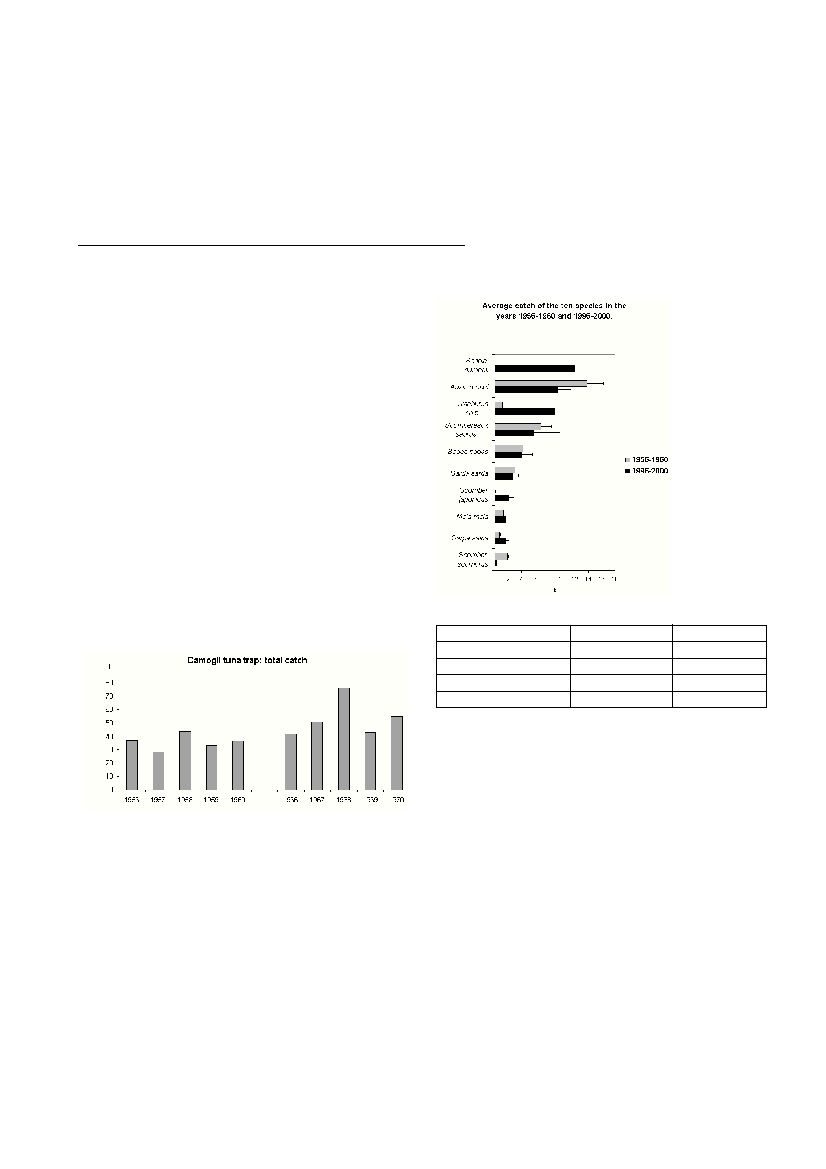Rapp. Comm. int. Mer Médit., 36,2001
314
Introduction
The tuna trap of Camogli (Ligurian Sea, Western Mediterranean) is an
installation which belongs to a pluricentenary tradition. It’s a small sized
tuna trap (about 8300 m
2
), still made of coconut fibre in prevalence, posi-
tioned near the Portofino headland.
The fishermen generally make three hauls per day (dawn, morning,
afternoon); sometimes more on indication of a guardian who observes with
a view-finder while fishes enter in the death chamber.
For their cooperative organization, fishers always noted catched species
in details in every single fish operation. Fishing statistics have been avail-
able since 1951. The catches of the 1951-74 period were described (1).
Since the characteristics of the installation are essentially unchanged in the
years, data recorded may be a valid witness of the evolution of the fish pop-
ulation.
Camogli’s tuna trap also provided records of the presence of new
species in the Mediterraean like the shark Sphyrna mokarran(2) and the
marlinMakaira indica(3).
Sharks have been the object of a paper which focused on a considerable
decrease from the fifties to seventies (4), a trend which was observed also
in Mediterranean demersal resources (5).
Methods
This work presents two sets of five years data (1956-1960, 1996-2000),
making a comparison on the yields and on the most abundant species. The
data belonging to the first period comes from literature (1); the last period
was elaborated thanks to the documentation belonging to the “Cooperativa
Pescatori Camogli”.
Shark catches have been analysed withouth considering some species
which now are released alive because they haven’t any commercial value
(i.e. Cethorinus maximus).
Results
Total catches appear to be increased (fig.1), but there are no significant
difference according to the Mann-Whitney test (U=2).
Figure 1 – Camogli tuna trap : total catches (t) in two periods, 1956-1960
and 1996-2000.
Considering the ten main species over the last years (fig. 2) Auxis rochei,
Sarda sardaandScomberesox saurusdecrease. On the contrary, increased
catches were recorded for Mola mola, Sarpa salpaand especially for
Carangidae with Trachurussp.p. and Seriola dumerili, which now is the
main species, while in the fifties was captured sporadically.Scomber
japonicusapparently has taken the place of Scomber scombrus.
Mola mola, despite the incresing occurence, has been recently banned
as a commercial product by the “ Italian Ministry of Health”, as a poten-
tial dangerous Tetraodontidae. So the landings are no more comparable.
Among the three shark families of potential commercial value only
Alopiidae has given some catches, confirming the above mentioned nega-
tive trend (Tab. 1).
The increase of Carangidae and other southern species such as
Sphyraena viridensismight be linked to the global warming of last years.
The spreeding of this family in the Mediterranean is confirmed by the
recent adding of two non native species (Seriola carpenteriandSeriola
f
a
s c
i
a
t
a) to the S .
dumerilifishery in the Sicilian Straits (6; Andaloro p.c.).
Tab. 1 – Camogli tuna trap : shark catches in the two periods.
References
1) Balestra V., Boero F., Carli A., 1976. Andamento del pescato della
tonnarella di Camogli dal 1950 al 1974. Valutazioni bio-statistiche. Boll.
Pesca Piscic. Idrobiol.31 (1-2) :105-115.
2) Boero F., Carli A., 1977. Prima segnalazione di Sphyrna mokarran
(Rüppel) (Selachii, Sphyrnidae). Boll. Mus. Ist. Biol. Univ. Genova45 : 91-93.
3) Orsi Relini L., Costa M.R., 1986. Cattura di un marlin a Camogli :
s
egnalazione di M
a
k
a
i
ra indica(Cuvier 1832) (Osteichthyes Istiophoridae)
nel Mediterraneo. Doriana, s
u
p
p
l
.An. Mus. Civ. Sci. Nat.G e
n
ova 6(259) :
1-4.
4) Boero F., Carli A., 1979. Catture di elasmobranchi nella tonnarella di
Camogli (Genova) dal 1950 al 1974. Boll. Mus. Ist. Biol. Univ. Genova47 :
27-34.
5) Aldelbert Y., 1974. Demersal resources of the Gul of Lions (NW
Mediterranean) impact of exploitation on fish diversity.Vie Milieu47(4) :275-
284.
6) Pizzicori Y., Castriota L., Marino G., Andaloro F., 2000.Seriola carpenteri
: a new immigrant in the Mediterranean from the Atlantic. Journal of Fish
Biology, 57(1) : 1335-1338.
CHANGES IN A NORTH WESTERN MEDITERRANEAN FISH COASTAL ASSEMBLAGE
ON THE BASIS OF THE CATCHES OF THE CAMOGLI TUNATRAP
Marco Relini
Laboratorio di Biologia Marina ed Ecologia Animale, Dip. Te. Ris, Universitŕ di Genova, Italia - largepel@unige.it
Abstract
The tuna trap of Camogli is an installation of small dimensions which operates from April to September.The fishermen who note down
the catched species with accuracy during every single fish operation, made fishing statistics available since 1951. Considering that the
characteristics of the installation are substantially unchanged in the years, the data recorded may be a valid witness of the evolution of the
fish population. This work presents the data corresponding to two periods of five years each (1956-1960, 1996-2000) making a comparison
on the yields and on the dominant species. During the last five years the Carangidae has become more important : in particular Seriola
dumeriliwhich in the fifties was a catch of secondary importance has become the most important species.
Keywords : tuna trap, fish-catches, Western Mediterranean, Seriola dumerili.
Figure 2 –
Camogli tuna
trap: average
catches (t) of ten
main species in
two periods
1956-1960 and
1996-2000.
Family
1956-60
1996-2000
Alopiidae
11
7
Carcharhinidae
1
0
Triakidae
13
0
Total
25
7

